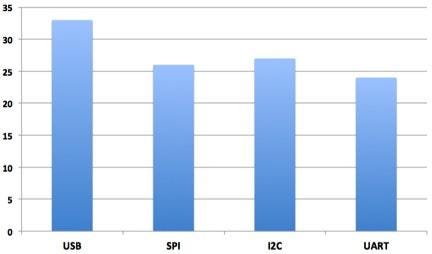The Importance of Serial Interfaces in FPGA Designs
January 27, 2015

I just finished my Design News CEC class on programmable logic last week and during the course I get to ask attendees a variety of questions about their designs. This is a great opportunity for me to learn something during the class since I get to see a variety of responses from engineers just starting their first design to seasoned experts.
Class attendees are also often from around the globe (often they are watching the class late at night even though it is a live broadcast at 11 a.m. for me on the west coast of the US) and represent a wide variety of industries. (I typically ask them what industry they design in.) Now I know the responses I get are not statistically robust (It's a captive audience who has self-selected to take my class...), but I can't help but try and draw some conclusions from the data I receive. Probably a hold over from the many customer interviews and product trade-offs I did during by strategic marketing days.
The thing that got me thinking this time was the response to the question I asked about the serial interfaces the students typically used on their FPGA designs. I received just over 50 responses and the most often mentioned interfaces were USB, I2C, SPI, and UART. This in itself wasn't much of a surprise since these are the interfaces most often provided by FPGA and SoC FPGA vendors. If you are going to use an interface, you use what is available or you select the FPGA that supports the interface you need, right?
The surprising thing to me was the number of mentions each of these interfaces received. A quick scan through the archive of the online chat (the way questions get asked and answered) shows the response tabulations in the figure below. Look it over and think about it for a bit to see if you are struck by the same things I am.

The two things that surprised me the most were:
The number of responses that mentioned USB (the most frequent interface mentioned).
The relatively equal number of responses for each type of interface.
Related articles on DesignNews.com
The fact the all the interfaces were mentioned in just about the same frequency was a bit of a surprise to me, too. I guess I expected one or two interfaces to dominate the responses, probably with SPI being the most frequent and UART being the least. This got me digging into the responses in more detail, too, and it turns out that in several cases all of these interfaces were used in the design. It was very unusual for the typical design to include only a single serial interface.
If you think about the 'role' of FPGAs in systems design these days the above results become a bit clearer. FPGAs are the glue logic in today's systems, but what they glue together are a variety of diverse sub-systems with different interface requirements. If you only needed a single type of interface, SPI for example, you probably wouldn't need an FPGA!
I guess its no wonder that FPGA manufacturers have added dedicated hardware to support serial interfaces on FPGAs and also provide the needed firmware, usually native to their development environment, to make them easy to use. After all, they don't want the FPGA designer to get "stuck" implementing the "glue" for all the serial interfaces within their systems.
Design engineers and professionals, the West Coast's most important design, innovation, and manufacturing event, Pacific Design & Manufacturing, is taking place in Anaheim, Feb. 10-12, 2015. A Design News event, Pacific Design & Manufacturing is your chance to meet qualified suppliers, get hands-on access to the latest technologies, be informed from a world-class conference program, and expand your network. (You might even meet a Design News editor.) Learn more about Pacific Design & Manufacturing here.
Warren Miller has more than 30 years experience in electronics and has held a variety of positions in engineering, applications, strategic marketing, and product planning with large electronics companies like Advanced Micro Devices, Actel, and Avnet, as well as with a variety of smaller startups.
About the Author(s)
You May Also Like



